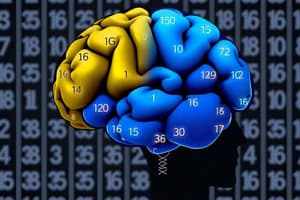Podcast
Questions and Answers
Which of the following tests is NOT a subscale of the Wechsler Adult Intelligence Scale (WAIS)?
Which of the following tests is NOT a subscale of the Wechsler Adult Intelligence Scale (WAIS)?
- Block Design
- Picture Arrangement
- Digit Symbol (correct)
- Object Assembly
What is the primary purpose of Raven's Progressive Matrices?
What is the primary purpose of Raven's Progressive Matrices?
- To determine a person's musical aptitude
- To measure abstract reasoning (correct)
- To assess verbal fluency
- To evaluate emotional intelligence
Which of the following is a potential misuse of intelligence test results?
Which of the following is a potential misuse of intelligence test results?
- Promoting eugenics policies and social exclusion (correct)
- Identifying children who might benefit from special education
- Evaluating the effectiveness of educational interventions
- Using them in clinical settings for diagnosis
The Flynn Effect refers to:
The Flynn Effect refers to:
Which of these factors contribute to the Flynn Effect?
Which of these factors contribute to the Flynn Effect?
What is the primary purpose of factor analysis in intelligence testing?
What is the primary purpose of factor analysis in intelligence testing?
What is the 'g' factor, coined by Galton, referring to in the context of intelligence?
What is the 'g' factor, coined by Galton, referring to in the context of intelligence?
Which of the following is NOT mentioned as a possible application of Raven's Progressive Matrices?
Which of the following is NOT mentioned as a possible application of Raven's Progressive Matrices?
What type of intelligence is primarily related to an individual's ability to solve abstract problems and see patterns in an inductive fashion?
What type of intelligence is primarily related to an individual's ability to solve abstract problems and see patterns in an inductive fashion?
What is a key difference between the psychometric and cognitive approaches to intelligence?
What is a key difference between the psychometric and cognitive approaches to intelligence?
What type of test is most likely to be used to assess crystallized intelligence?
What type of test is most likely to be used to assess crystallized intelligence?
What does the correlation between CAT scores and GCSE performance (0.81) tell us about the relationship between intelligence and academic achievement?
What does the correlation between CAT scores and GCSE performance (0.81) tell us about the relationship between intelligence and academic achievement?
Based on the studies mentioned, what is a factor that can potentially lead to cognitive decline?
Based on the studies mentioned, what is a factor that can potentially lead to cognitive decline?
According to Brenda Plassman's research, which of the following is NOT a factor that can contribute to faster cognitive decline?
According to Brenda Plassman's research, which of the following is NOT a factor that can contribute to faster cognitive decline?
What is the relationship between intelligence and longevity, based on the Scottish Mental Survey?
What is the relationship between intelligence and longevity, based on the Scottish Mental Survey?
Which of the following is NOT a factor commonly associated with crystallized intelligence?
Which of the following is NOT a factor commonly associated with crystallized intelligence?
What does Sternberg's research on individual conceptions of intelligence encompass?
What does Sternberg's research on individual conceptions of intelligence encompass?
Which of the following correctly defines implicit theories of intelligence?
Which of the following correctly defines implicit theories of intelligence?
What is a common challenge faced by researchers when studying intelligence?
What is a common challenge faced by researchers when studying intelligence?
Which of the following demonstrates the concept of operationalization, as applied to intelligence?
Which of the following demonstrates the concept of operationalization, as applied to intelligence?
What did Sternberg's research on individual conceptions of intelligence suggest about people's understanding of intelligence?
What did Sternberg's research on individual conceptions of intelligence suggest about people's understanding of intelligence?
According to the provided information, what is a key difference in the cognitive emphasis between Western and Non-Western cultures?
According to the provided information, what is a key difference in the cognitive emphasis between Western and Non-Western cultures?
Which of the following is NOT a characteristic observed in an ideal 6-month-old baby, according to the information provided?
Which of the following is NOT a characteristic observed in an ideal 6-month-old baby, according to the information provided?
According to the information, which of the following is a hallmark of intelligence in a 10-year-old child?
According to the information, which of the following is a hallmark of intelligence in a 10-year-old child?
What was a key finding from Sternberg's study involving 200 professors?
What was a key finding from Sternberg's study involving 200 professors?
Which of the following is NOT included in Sternberg's three dimensions of intelligence?
Which of the following is NOT included in Sternberg's three dimensions of intelligence?
According to the information provided, what is the significance of the Moray House Test No. 12?
According to the information provided, what is the significance of the Moray House Test No. 12?
Which of the following is NOT directly related to the concept of savant syndrome?
Which of the following is NOT directly related to the concept of savant syndrome?
Which characteristic is particularly emphasised by Berg & Sternberg (1992) in their approach to intelligence?
Which characteristic is particularly emphasised by Berg & Sternberg (1992) in their approach to intelligence?
Which of the following is NOT a primary mental ability according to Thurstone?
Which of the following is NOT a primary mental ability according to Thurstone?
According to Spearman's theory, what is the relationship between specific intelligences and general intelligence (g)?
According to Spearman's theory, what is the relationship between specific intelligences and general intelligence (g)?
Which of the following is NOT a characteristic of Thurstone's primary mental abilities theory?
Which of the following is NOT a characteristic of Thurstone's primary mental abilities theory?
What is the purpose of rotating a component matrix in factor analysis?
What is the purpose of rotating a component matrix in factor analysis?
Which of the following is NOT a key difference between Spearman's and Thurstone's theory?
Which of the following is NOT a key difference between Spearman's and Thurstone's theory?
According to Carroll's 3-stratum model, what relationship exists between the Stratum I and Stratum III levels?
According to Carroll's 3-stratum model, what relationship exists between the Stratum I and Stratum III levels?
Which of the following is considered to be a characteristic of individuals who have high general intelligence (g) according to Carroll's 3-stratum model?
Which of the following is considered to be a characteristic of individuals who have high general intelligence (g) according to Carroll's 3-stratum model?
Which theory emphasizes the presence of several narrower abilities within each stratum level in Carroll's model?
Which theory emphasizes the presence of several narrower abilities within each stratum level in Carroll's model?
What was a major finding that ultimately led to the decline of James McKeen Cattell's 'mental tests'?
What was a major finding that ultimately led to the decline of James McKeen Cattell's 'mental tests'?
Binet's approach to intelligence testing can be characterized as pragmatic. What does this mean in the context of his work?
Binet's approach to intelligence testing can be characterized as pragmatic. What does this mean in the context of his work?
The Binet-Simon scale differed significantly from Cattell's 'mental tests'. What was a key difference?
The Binet-Simon scale differed significantly from Cattell's 'mental tests'. What was a key difference?
Who initially coined the term 'Intelligence Quotient' (IQ)?
Who initially coined the term 'Intelligence Quotient' (IQ)?
Which of the following is NOT a core component assessed by the Wechsler intelligence scales (WAIS and WISC)?
Which of the following is NOT a core component assessed by the Wechsler intelligence scales (WAIS and WISC)?
The development of IQ testing has seen significant advancements over time. What is a key difference between the Binet-Simon scale and the Wechsler scales?
The development of IQ testing has seen significant advancements over time. What is a key difference between the Binet-Simon scale and the Wechsler scales?
What was the primary objective of Robert Yerkes' Alpha and Beta tests?
What was the primary objective of Robert Yerkes' Alpha and Beta tests?
The Stanford-Binet test is considered a revision of the Binet-Simon scale. What is a significant difference between the two tests?
The Stanford-Binet test is considered a revision of the Binet-Simon scale. What is a significant difference between the two tests?
Why is it more accurate to describe intelligence as 'genetics × environment' rather than 'genetics + environment'?
Why is it more accurate to describe intelligence as 'genetics × environment' rather than 'genetics + environment'?
What is a key assumption made when using twin studies to assess the heritability of intelligence?
What is a key assumption made when using twin studies to assess the heritability of intelligence?
According to twin studies, what happens to the influence of genetic and shared environmental factors on intelligence as individuals age?
According to twin studies, what happens to the influence of genetic and shared environmental factors on intelligence as individuals age?
The results from Claire Haworth’s dataset involving twin studies suggest which of the following regarding the causes of differences in intelligence?
The results from Claire Haworth’s dataset involving twin studies suggest which of the following regarding the causes of differences in intelligence?
What conclusion can be drawn from the difference in heritability estimates of intelligence derived from twin studies versus GWAS studies?
What conclusion can be drawn from the difference in heritability estimates of intelligence derived from twin studies versus GWAS studies?
If an intelligence test has high concurrent validity, what would you expect to observe?
If an intelligence test has high concurrent validity, what would you expect to observe?
What does it mean for an intelligence test to have good predictive validity?
What does it mean for an intelligence test to have good predictive validity?
What does high internal reliability in an intelligence test indicate about the test items?
What does high internal reliability in an intelligence test indicate about the test items?
In what way might emotional intelligence (EI) be most effectively applied in practical settings?
In what way might emotional intelligence (EI) be most effectively applied in practical settings?
What distinguishes wisdom from other forms of intelligence, such as emotional or analytical intelligence?
What distinguishes wisdom from other forms of intelligence, such as emotional or analytical intelligence?
How does creativity, as a form of intelligence, commonly manifest itself?
How does creativity, as a form of intelligence, commonly manifest itself?
When evaluating intelligence test results for job recruitment, what considerations should be prioritized to ensure ethical and effective use?
When evaluating intelligence test results for job recruitment, what considerations should be prioritized to ensure ethical and effective use?
What broader purpose do intelligence tests serve beyond simple ability assessment?
What broader purpose do intelligence tests serve beyond simple ability assessment?
Which elementary cognitive task (ECT) primarily assesses the speed at which an individual can differentiate between similar stimuli?
Which elementary cognitive task (ECT) primarily assesses the speed at which an individual can differentiate between similar stimuli?
What does a smaller standard deviation in reaction time, measured across multiple trials in an Elementary Cognitive Task (ECT), generally indicate?
What does a smaller standard deviation in reaction time, measured across multiple trials in an Elementary Cognitive Task (ECT), generally indicate?
In the context of Elementary Cognitive Tasks (ECTs), what does 'inspection time' specifically measure?
In the context of Elementary Cognitive Tasks (ECTs), what does 'inspection time' specifically measure?
How might researchers use Elementary Cognitive Tasks (ECTs) such as visual search in conjunction with reaction time measurements to understand cognitive abilities?
How might researchers use Elementary Cognitive Tasks (ECTs) such as visual search in conjunction with reaction time measurements to understand cognitive abilities?
Which of the following is the LEAST likely application of Elementary Cognitive Tasks (ECTs)?
Which of the following is the LEAST likely application of Elementary Cognitive Tasks (ECTs)?
Flashcards
Intelligence
Intelligence
A general mental ability to learn, adapt, and simplify complexities.
Latent variable
Latent variable
An underlying concept that cannot be directly measured.
Fluid intelligence
Fluid intelligence
Using language to simplify complex information for better understanding.
Implicit vs. Explicit Intelligence
Implicit vs. Explicit Intelligence
Signup and view all the flashcards
Sternberg's study
Sternberg's study
Signup and view all the flashcards
Western cultures' cognitive emphasis
Western cultures' cognitive emphasis
Signup and view all the flashcards
Non-Western cultures' cognitive skills
Non-Western cultures' cognitive skills
Signup and view all the flashcards
Development milestones (6 months)
Development milestones (6 months)
Signup and view all the flashcards
Development milestones (2 years)
Development milestones (2 years)
Signup and view all the flashcards
Development milestones (10 years)
Development milestones (10 years)
Signup and view all the flashcards
Sternberg's three dimensions of intelligence
Sternberg's three dimensions of intelligence
Signup and view all the flashcards
Berg & Sternberg (1992) significance
Berg & Sternberg (1992) significance
Signup and view all the flashcards
Savant syndrome
Savant syndrome
Signup and view all the flashcards
Sir Francis Galton
Sir Francis Galton
Signup and view all the flashcards
James McKeen Cattell
James McKeen Cattell
Signup and view all the flashcards
Clark Wissler
Clark Wissler
Signup and view all the flashcards
Alfred Binet
Alfred Binet
Signup and view all the flashcards
Binet-Simon scale
Binet-Simon scale
Signup and view all the flashcards
William Stern
William Stern
Signup and view all the flashcards
Stanford-Binet test
Stanford-Binet test
Signup and view all the flashcards
Wechsler-Bellevue Scale
Wechsler-Bellevue Scale
Signup and view all the flashcards
Spearman's 2 Factor Theory
Spearman's 2 Factor Theory
Signup and view all the flashcards
Thurstone's Primary Mental Abilities
Thurstone's Primary Mental Abilities
Signup and view all the flashcards
Thurstone's 7 Abilities
Thurstone's 7 Abilities
Signup and view all the flashcards
Carroll's 3 Stratum Model
Carroll's 3 Stratum Model
Signup and view all the flashcards
Stratum III
Stratum III
Signup and view all the flashcards
Stratum II
Stratum II
Signup and view all the flashcards
Stratum I
Stratum I
Signup and view all the flashcards
Rotated Component Matrix
Rotated Component Matrix
Signup and view all the flashcards
Wechsler Adult Intelligence Scale (WAIS)
Wechsler Adult Intelligence Scale (WAIS)
Signup and view all the flashcards
Flynn Effect
Flynn Effect
Signup and view all the flashcards
Raven's Progressive Matrices
Raven's Progressive Matrices
Signup and view all the flashcards
Cultural Specificity Bias
Cultural Specificity Bias
Signup and view all the flashcards
Correlation in Intelligence Testing
Correlation in Intelligence Testing
Signup and view all the flashcards
Galton's g Factor
Galton's g Factor
Signup and view all the flashcards
Structural Inequalities
Structural Inequalities
Signup and view all the flashcards
Intelligence Test Misuse
Intelligence Test Misuse
Signup and view all the flashcards
Crystallized intelligence
Crystallized intelligence
Signup and view all the flashcards
Psychometric approach
Psychometric approach
Signup and view all the flashcards
Cognitive approach
Cognitive approach
Signup and view all the flashcards
Elementary Cognitive Tasks (ECT)
Elementary Cognitive Tasks (ECT)
Signup and view all the flashcards
Correlation of intelligence and life outcomes
Correlation of intelligence and life outcomes
Signup and view all the flashcards
Brenda Plassman's findings
Brenda Plassman's findings
Signup and view all the flashcards
Scottish Mental Survey
Scottish Mental Survey
Signup and view all the flashcards
Intelligence: Nature vs. Nurture Interaction
Intelligence: Nature vs. Nurture Interaction
Signup and view all the flashcards
Family Studies
Family Studies
Signup and view all the flashcards
Adoption Studies
Adoption Studies
Signup and view all the flashcards
Twin Studies
Twin Studies
Signup and view all the flashcards
Heritability of Intelligence
Heritability of Intelligence
Signup and view all the flashcards
Face validity
Face validity
Signup and view all the flashcards
Concurrent Validity
Concurrent Validity
Signup and view all the flashcards
Predictive Validity
Predictive Validity
Signup and view all the flashcards
Intelligence Tests
Intelligence Tests
Signup and view all the flashcards
Emotional Intelligence (EQ)
Emotional Intelligence (EQ)
Signup and view all the flashcards
Wisdom
Wisdom
Signup and view all the flashcards
Creativity
Creativity
Signup and view all the flashcards
Duncker Candle Problem
Duncker Candle Problem
Signup and view all the flashcards
Inspection Time
Inspection Time
Signup and view all the flashcards
Standard Deviation Reaction Time
Standard Deviation Reaction Time
Signup and view all the flashcards
Mean Reaction Time
Mean Reaction Time
Signup and view all the flashcards
Response Time
Response Time
Signup and view all the flashcards
Study Notes
Introduction to Intelligence
- Fluid intelligence uses language as a scientific device to simplify complexity.
These are separated into:
-
Implicit:
-
Constructs in a person's mind
-
Used for formulating cross-cultural views about intelligence
-
Can help understand or provide basis for explicit theories
-
Data is derived from asking people their notion of intelligence
-
Drive the way people evaluate their own and other people's intelligence
-
Explicit:
-
Conducted by scientists
-
Based on data collected
-
Performance on tasks presumed to measure intelligence
-
Constructs could be factors, components, or schemata
-
Difficult to agree on operational definition of intelligence
Development of Brain Areas
- Siegler & Richards (1982) study asked US adults to describe ideal intelligent persons at the ages of 6 months, 2 years, 10 years and as adults.
Ideal Intelligent Person Attributes
- Ideal attributes for an intelligent person in Arts are:
- Knowledge
- Ability to use knowledge
- Weigh alternatives
- See analogies
- Ideal attributes for an intelligent person in Business include:
- Logical thinking
- Focusing on essential aspects
- Following arguments
- Ideal attributes for an intelligent person in Philosophy include:
- Critical and logical abilities
- Following complex arguments
- Finding errors
- Generating new arguments
- Ideal attributes for an intelligent person in Physics include:
- Precise mathematical thinking
- Relating phenomena to physics concepts
- Grasping laws of nature quickly
Theories of Intelligence
- Spearman's 2 factor theory of intelligence describes the specific intelligences of verbal, mechanical, spatial and math, and the g or general form of intelligence
Studying That Suits You
Use AI to generate personalized quizzes and flashcards to suit your learning preferences.




